Monte Enterprises
Beginning in the 1960s, Monte Enterprises published over sixty paper models of historic houses and landmarks. At a time when most American paper cutout toys were made for small children, founder Robert Monte created challenging model kits designed for older kids and adults interested in American history. The company started a revival of interest in architectural paper modeling in the U.S. which continues to this day.
Robert Monte was born in New York in 1921 and grew up next door to his paternal grandparents who had immigrated from Italy in about 1905. A few years after Robert was born, his grandfather began working in the rendering industry – the processing of animal carcasses into commodities such as tallow, oil, and bone meal fertilizer – which would become a family business for Robert's father, uncle and later himself.
After his grandparents visited Italy in the 1930s they gave young Robert some European paper cutout models as souvenirs, which made a strong impression on the teenager.
In 1938 the family moved to Delaware, where Robert studied for an engineering degree at the University of Delaware for two years before enlisting in the Army Corps of Engineers in 1942. He served in the Pacific and rose to the rank of Captain.
Returning to Wilmington after the war, Monte worked with his parents at the Joseph B. Beste rendering company and eventually became president of the company. In search of a new challenge and milder winter weather, he moved in 1952 with his wife Mary and two young children to the coastal city of New Bern, North Carolina and founded the Craven Rendering Company on the western outskirts of town.
Monte Enterprises was founded in 1963. According to his son Pete, Robert Monte had been reading a book about paper folding and origami and noticed an illustration. He suddenly recognized that the 2-dimensional pattern in the book would create the 3-dimensional structure of a real-life building. This "Eureka" moment inspired his first paper model kit of the Old Market House in nearby Fayetteville, NC and an idea to produce an entire line of scale model kits of landmark buildings to teach young people about history and architecture.
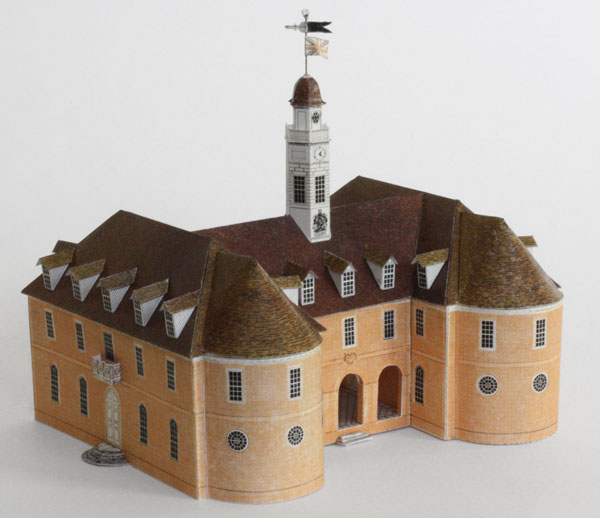
Capitol Building at Colonial Williamsburg (1964)
Over the next two years Monte Enterprises released a handful of new kits of nearby subjects in North Carolina and Virginia. Mr. Monte hired college students and young artists to help with the tedious process of drawing the test models to exact scale, fitting the pieces into layouts and finalizing the artwork. In 1965 Bill Burchette worked for the company as a summer job between college semesters. In a recent interview, he recalled that he had not been familiar with paper models previously, but a high-school drafting class was considered experience enough to land him the job. He and several other young employees worked at drafting tables in an area to the side of Mr. Monte's office at the rendering plant.
Designing the models involved a lot of careful manual effort. Using a 3-sided architect's scale ruler, Burchette calculated the sizes of the model parts from dimensions and plans of the original buildings that Mr. Monte gathered through his research. He and other artitsts used a lot of trial-and-error to test-build the models, tracing and redrawing the design to refine the basic shapes of the pieces.
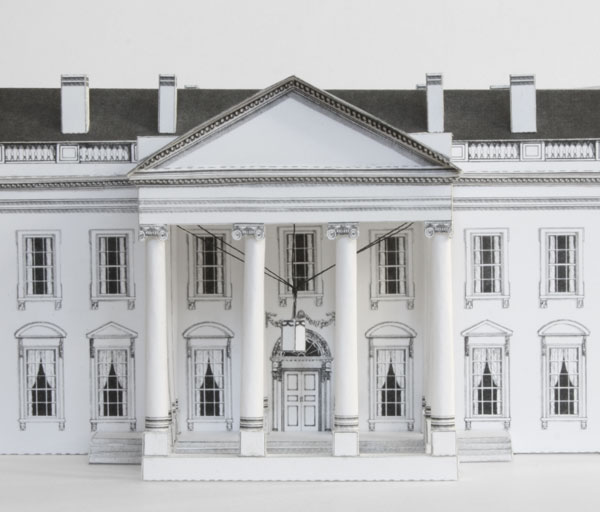
Detail of North Portico of the White House (1965)
Over the summer, Burchette created the designs for models of Tryon Palace, Independence Hall and the White House, which would eventually become some of the best sellers for Monte Enterprises. April Holton drew the finished artwork for the pieces and Robert Truitt fitted the layouts on each sheet and prepared them for printing.
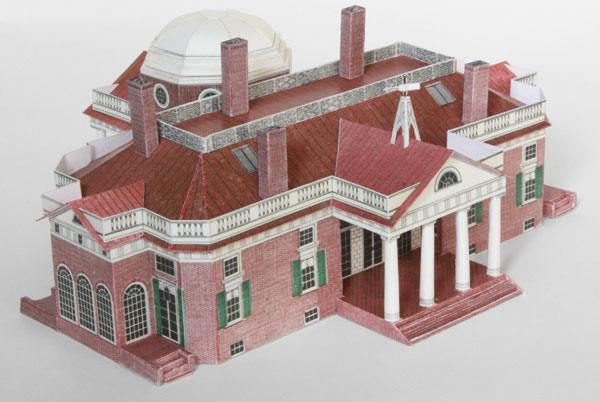
Monticello (1968)
Mr. Monte was involved in many different clubs and activities. He was an active member of the Eastern Carolina Yacht Club, First Presbyterian Church, the Chamber of Commerce, and the Elks Club as well as other local community organizations, including serving as board member of a local community development group called Craven Operation Progress (COP). Bill Burchette recalls that "his brain was always working," coming up with ideas for new entrepreneurial projects. Seeing an untapped market in the boaters and waterskiers out on the Trent and Neuse rivers in New Bern, Monte anchored a barge in the middle of the river and set up a floating store to sell snacks and boat fuel.
In the fall of 1965 the COP board elected Mr. Monte as its executive director. In order to accept the full-time job, he appointed a temporary manager of the rendering company and took a hiatus from Monte Enterprises. COP was one of the first initiatives of President Lyndon Johnson's "War on Poverty" program which sought to end poverty through education, jobs training and other programs. It became nationally recognized as a model for rural development. Monte served as its executive director for one year.
Monte returned to managing the rendering company and Monte Enterprises at the end of 1966. Soon thereafter, the company hired Janet Latham, a commercial artist trained at the Pratt Institute in New York, who would become an enthusiastic collaborator in designing the kits and promoting and selling them nationwide. As she explains: "There is nothing I like better than putting small things together!"
Miss Latham encouraged Mr. Monte to send a White House kit to a congressman that he had met through his work with COP. The congressman wasn't sure what to do with the thing so he sent it on to the Smithsonian Museum. Managers at the Smithsonian gift shop saw the model and immediately placed an order for 250 kits, far more than the company had ever previously sold.
The new exposure led to a collaboration with the National Trust for Historic Preservation to design and produce four new kits in just four months in time for their October 1967 convention in St. Louis. Monte Enterprises later created many other kits of historic houses with the help of the National Trust and local historical societies.
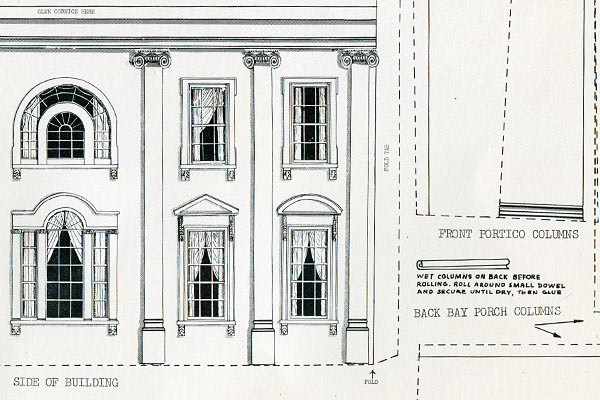
Detail of art for White House model by April Holton. Revised printing 1968.
Artwork for the kits was drawn in black and white with a Rapidograph technical ink pen, with flat areas of color added later to indicate rooftops or wall areas. The artwork used simple blocks of color without shading and a scale-sized stock brick pattern appears on many of the models. The Plimouth Plantation kit is an exception, with shaded coloration to illustrate the rough texture of the original buildings. For the other models, the printing press operator mixed the spot ink colors to match the materials depicted, leading to slight variations with each reprinting.
Monte model kits were printed with two to four spot colors on two to ten sheets of roughly 200 GSM cardstock. The early model of the North Carolina State Capitol is printed on grey cardstock but the other kits were printed on ivory-colored paper.
Curiously, the earliest model designs by Mr. Monte and artists under his direction used a dotted line to indicate the outline of the pieces and solid lines to indicate folds. By 1969 these symbols were reversed to the more conventional solid outlines and dotted fold lines.
Almost all of the models were designed to the consistent scale of 1:120 so that the completed models could be displayed together. Though they were designed over more than a dozen-year time span by a variety of artists, the artwork is drawn in a consistent style and the designs share common features such as rolled columns and internal bracing with circular openings. A 1974 Monte Models catalog advised that "some are more complex than others", though the kits were never labelled by level of difficulty. Buildability is made easier by the large scale, but most of the models include some small pieces as well as open porches or towers which add complexity to the forms of the built structures.
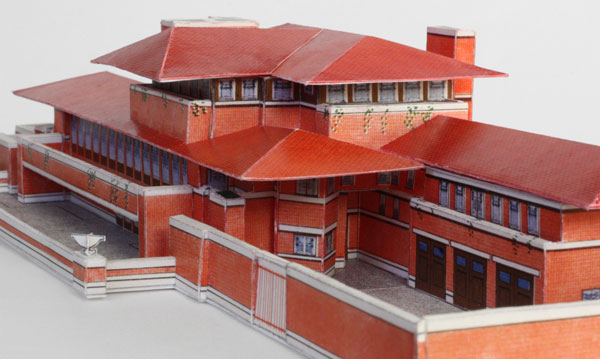
Detail of Robie House model designed by Ellen Kirven Sherratt (1969)
Each kit included a cover sheet with a short history of the building and written instructions and an assembly diagram on the back. The earlier kits were sold in large paper envelopes suitable for mailing, but after about 1973 they were sealed in shrink-wrapped plastic.
Robert and Mary Monte traveled to many of the subjects of the model kits on research trips across the country. Local historical societies and museum staff helped provide research materials, sometimes quite generously. The University of Chicago loaned original Frank Lloyd Wright blueprints of the Robie House to help with that model's design. Other museums were not so friendly. Pete Monte tells of one museum which was dissatisfied that the color of the roof of the printed model did not match the original building, and therefore declined to carry it in their shop. Once the model kits were printed, maintaining sales relationships with gift shops at dozens of small museums often run by volunteer staff remained a constant challenge.
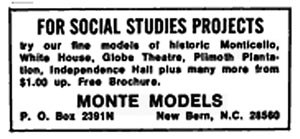
Classified ad in Today's Education magazine, 1971.
In about 1970 Monte Enterprises began importing a small number of model kits from J.F. Schreiber, Ingénia and other European publishers and offering them for sale to mail-order customers in the United States. Small advertisements in the back pages of history and education magazines attracted a devoted following of paper model enthusiasts. The business never became especially profitable for Mr. Monte, but a steady handful of mail orders arrived at the office every day. The White House and Independence Hall kits were most popular and were reprinted several times.
The Monte Enterprises office staff included as many as three artists working on different designs during its busiest years in 1968-69 and the years leading up to the American Bicentennial in 1976. Only one or two of the kits include information about who exactly drew or designed each model. Janet Latham recalled Monticello as a favorite of her designs.
Monte Enterprises changed its name to Monte Models in 1973, about the same time that the company decided to buy printing equipment to print its kits in-house rather than waiting on the unpredictable schedules of local printers. With its own presses set up in a small addition next to the rendering plant, they could print more model sheets whenever needed, as well as print jobs for other customers.
One of the later kits released by the company was a very large model of the U.S. Capitol, which Monte claimed to be the world's largest paper model. Even at 1:240 scale –half the scale of the other kits – the Capitol requires 32 sheets to fit all the pieces, and is over three feet wide and 18 inches tall when complete. The kit includes instructions on how to delegate the construction to teams of builders to complete the model as a group project.
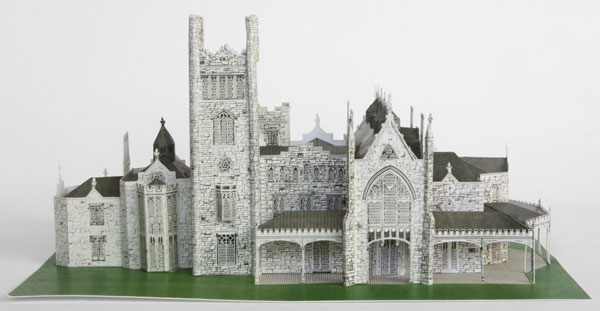
Lyndhurst mansion, the last Monte Models kit, released in 1979.
Monte Models released new kit designs each year until 1976. In 1980 Mr. Monte sold the rendering company and retired from Monte Enterprises as well. His son Pete moved the printing equipment to a new location across town, and the company became a full-service print shop handling large and small printing orders. Monte Printing is still in operation today.
Monte Printing continued to reprint and make minor revisions to several of the more popular kits such as the Robie House through the mid-1980s. The family sold most of the remaining stock of model kits to Lou Dausse's Paper Models International distribution company in Oregon in 1985. After a brief illness, Robert Monte passed away in 2002.
A German version of this article appears in the 2019 Zur Geschichte des Kartonmodellbaus journal published by the Arbeitskreis Geschichte des Kartonmodellbaus (AGK)
A complete list of published paper model work by Monte Enterprises:
References
Robert R. Monte obituary, July 2002, Sun-Journal, New Bern
"A Moderate Approach: How the War on Poverty Was Kept Alive in Eastern North Carolina, 1963-1968", Karen M. Hawkins, The Journal of the Historical Society, September 3, 2013
Phone interview with Pete Monte, July 2017
Phone interview with Janet Latham, August 2017
Phone interview with Bill Burchette, November 2018